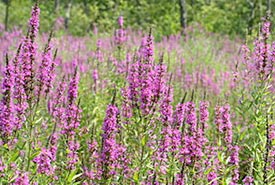
Purple loosestrife (Photo by Liz West, Wikimedia Commons)
Purple loosestrife
Purple loosestrife is a wetland plant native to Europe and Asia that was brought to North America in the early 19th century. This highly invasive plant was likely introduced when its seeds were included in soil used as ballast in European sailing ships and discarded in North America. The plant was also spread by early settlers and is still used in flower gardens and occasionally sold in nurseries today.
How is it identified?
This invasive can grow up to one-and-a-half metres in height, and it flowers pink-purple from May to June. Its leaves are in pairs or whorls of three, lance-shaped and oppositely arranged on the stems, which are woody and square.
Where does it grow?
Purple loosestrife has now naturalized and spread across Canada and the northern United States. It can be found in wet meadows, river floodplains and damp roadsides.
This plant aggressively degrades and lowers the value of a wetland for use by wildlife, clogs irrigation and drainage ditches and chokes out native vegetation.
How can you help?
Hand dig small plants and/or remove flower heads before they seed. Plant material can be incinerated or rotted in black garbage bags in the sun for at least a week prior to disposal in a landfill. To eradicate the population, control treatment will need to be repeated over multiple years.
Everyone can help to win the battle against alien invasive species. Here are some ways you can help:
- Dispose of yard waste properly. Dumping yard waste in natural areas can introduce alien invasive species that will thrive and spread. Even leaf piles can be problematic, as dumped piles can smother native vegetation. Contact your municipality to find out how to dispose of yard waste properly.
- Plant native species in your garden. There are lots of beautiful native species that attract native butterflies and birds, making your garden twice as beautiful. Native species are also adapted to our climate and often require less rigorous care than exotic species.
- Report sightings of invasive plants to your local stewardship council. Finding these invasions early is key to eradicating them.
- Clean your shoes or bicycle tires when moving between designated trails in different areas. Invasive plants are often spread accidentally from seeds stuck in treads.



